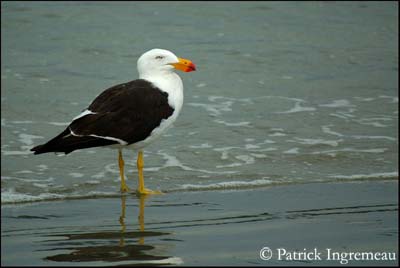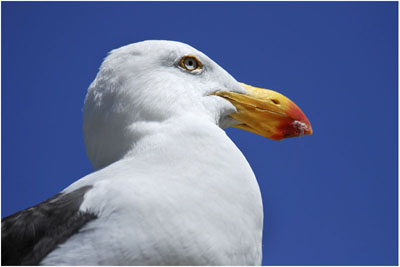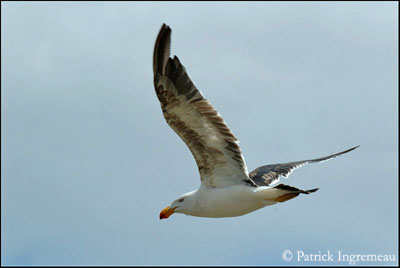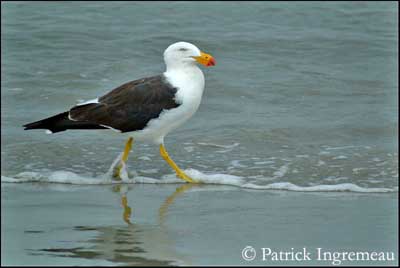
Pacific Gull
Larus pacificus
Charadriiforme Order – Laridae Family
BIOMETRICS:
Length : 58-65 cm
Wingspan : 165-155 cm
Weight : 900-1180 gr
LONGEVITE : Up to 15 years
DESCRIPTION:
Pacific Gull is a large gull with powerful bill, endemic to Australia.
Adult has black upperparts. Wings are black with narrow white trailing edge. Mantel is black. Tail is white with black subterminal band.
Underparts are pure white.
Head is white. Yellow bill is massive and large, with red tip. Eyes are white.
Legs and webbed feet are yellow or orange-yellow.
PROTECTION / THREATS / STATUS:
Pacific Gull is often disturbed at breeding sites by humans, although nest-sites are naturally protected by their inaccessibility.
However, this species is often seen scavenging on human refuse, at picnic areas and abattoirs, or near wharves for fish. Populations seem to be stable at this moment.
Fr: Goéland austral
All : Dickschnabelmöwe
Esp : Gaviota Tasmania
Ital : Gabbiano del Pacifico
Nd : Diksnavelmeeuw
Photographs by Patrick Ingremeau
His website: TAMANDUA
Text by Nicole Bouglouan
Sources:
HANDBOOK OF THE BIRDS OF THE WORLD Volume 3 by Josep del Hoyo-Andrew Elliott-Jordi Sargatal - Lynx Edicions - ISBN : 8487334202
Birds in backyards (Birds Australia and Australian Museum)
Wikipedia (Wikipedia, The Free Encyclopedia)
BirdLife International (BirdLife International)
Arthur Grosset's Birds (Arthur Grosset)

We find two forms of Pacific Gull:
The eastern race L.p. pacificus has white eyes and the bill is tipped red.
The western race L.p. georgii has red eyes, and bill with incomplete red tip.
Both sexes are similar.
Juvenile is heavily spotted dark brown, but it has white face. Bill is pinkish and black-tipped. Eyes are dark. Legs are brownish.
Immature has darker brown wings. Whitish body is mottled brown. It has yellow black-tipped bill.
Young needs about 4 to 5 years for reaching complete adult plumage.
Pacific Gull resembles Kelp Gull, which is smaller and with smaller bill.
VOICE: SOUNDS BY XENO-CANTO
Pacific Gull gives loud “ow-ow”, and also utters muffled “awk-awk”.
HABITAT:
Pacific Gull is rather a bird of shores than of oceans. It is often seen along local beaches, or flying on shore-line searching for food. It frequents estuaries, sheltered bays or harbours, but avoids human areas. It is sometimes seen in farmlands and rubbish-dumps in coastal areas.
RANGE:
Pacific Gull is native and lives in Southern Australia, mostly on south and west coasts, and Tasmania. It can be seen sometimes on the east coasts.
It mainly breeds in Tasmania, in Bass Strait Islands, and westwards along Victorian coasts.

BEHAVIOUR:
Pacific Gull feeds on aquatic invertebrates along the coasts, flying on the shore line searching for food.
This gull sometimes takes preys such as crabs or sea urchins, and it drops them onto rocks in order to break them open. It drops them from the air, at about 10 to 15 metres while flying.
It is usually seen alone or in pairs, flying along shore line, high above the water edge. Pacific Gull is shyer than Silver Gull which is an aggressive sea bird.
Pacific Gull adult is sedentary in its range, but young may disperse after breeding season.
FLIGHT:
Pacific Gull frequently loafs around shore line, gliding high while searching for food. When in flight, we can see the conspicuous white trailing edges on wings and its wedged tail.

REPRODUCTION:
Breeding season occurs between September and December.
This species nests in pairs or in small colonies, usually on offshore islands. Nest is situated on the ground, usually hidden among vegetation or rocks.
We can find two kinds of nests. As it is a scrape, a shallow depression in the ground, sometimes lined with gravel, or it is a shallow cup made with plant materials, seaweed and twigs, and sometimes feathers. Nest is built by both adults.
Female usually lays 2, maybe 3 mottled brown eggs. Incubation lasts about 28 days, shared by both parents, but mainly by female. Male provides food and defends the nest.
Young are fed by both parents.
DIET:
Pacific Gull feeds mainly on aquatic invertebrates such as molluscs, squid, crabs, sea-urchins and varied crustaceans. It also consumes fish, small seabirds, eggs and nestlings, and also carrion.
